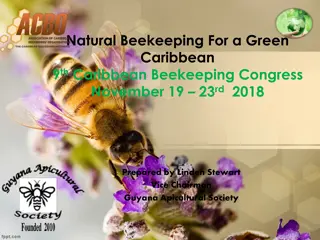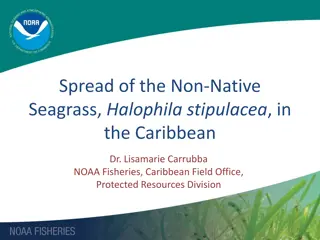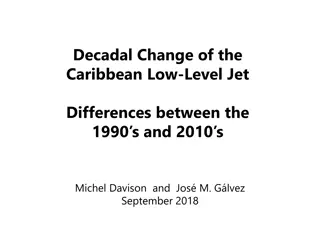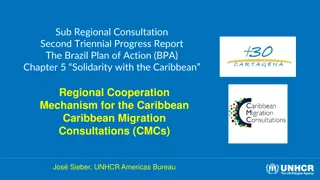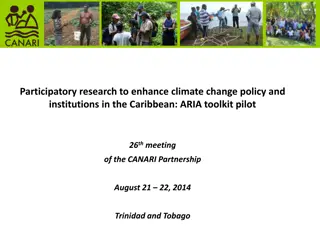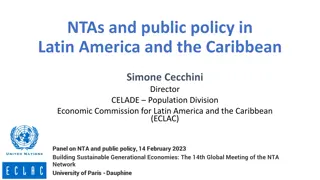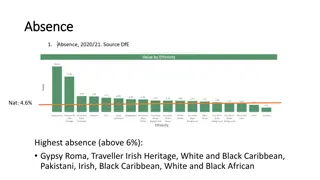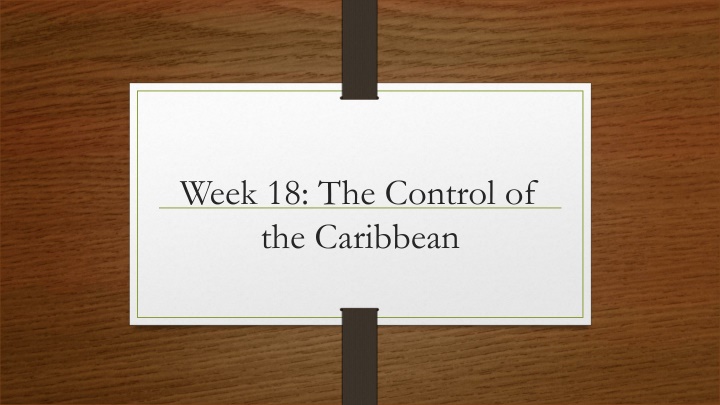
Uncovering the Medical History of the Caribbean: Yellow Fever, Race, and Warfare
Explore the historical narrative of yellow fever, racial differences in health outcomes, and the impact of tropical diseases on warfare in the Caribbean during the 18th century. Delve into how perceptions of race, climate, and diet influenced medical practices and military strategies during this pivotal period.
Download Presentation

Please find below an Image/Link to download the presentation.
The content on the website is provided AS IS for your information and personal use only. It may not be sold, licensed, or shared on other websites without obtaining consent from the author. If you encounter any issues during the download, it is possible that the publisher has removed the file from their server.
You are allowed to download the files provided on this website for personal or commercial use, subject to the condition that they are used lawfully. All files are the property of their respective owners.
The content on the website is provided AS IS for your information and personal use only. It may not be sold, licensed, or shared on other websites without obtaining consent from the author.
E N D
Presentation Transcript
Week 18: The Control of the Caribbean
Rana A. Hogarth, Medicalizing Blackness: Making Racial Difference in the Atlantic World, 1780-1840 (Chapel Hill: University of North Carolina Press, 2017), 'Ch. 2: An African Corps in a Most Distressed and Sickly Condition: Yellow Fever in the West Indies,' pp. 48-77. Fergusson questioned why the "morbific" miasma causing the yellow fever outbreak appeared to affect black and white individuals differently. He and others observed that black recruits and white crew members experienced distinct symptoms from the same disease. Fergusson concluded that yellow fever affected both black and white individuals but under different external conditions. He examined factors such as the feeding and management of black troops to explain variations in symptoms. Fergusson's inquiry was based on the assumption that black and white bodies responded differently to external conditions, particularly focusing on how black troops were fed and managed on the ship. By 1846, British physicians increasingly attributed disparities in black and white mortality rates in the tropics to inherent racial traits rather than external factors. Captain Alexander M. Tulloch s military report challenged the belief that black troops were well-suited for hot climates. Using statistical data, he highlighted high mortality rates among black soldiers, casting doubt on their supposed natural advantage in such environments. QUOTE: "Blackness held the promise of lending precision to existing princi ples of medicine that stressed the interactions between race, climate, region, and diet as a means of understanding health and sickness."
Kenneth F. Kiple and Krimhild Conee Ornelas, Race, War and Tropical Medicine in the Eighteenth-Century Caribbean, in David Arnold (ed.), Warm Climates and Western Medicine: The Emergence of Tropical Medicine, 1500-1900 (Amsterdam, 1996), pp.65-79. Physicians' training was severely inadequate. Their training instilled preconceived notions that frequently blinded them to critical epidemiological, etiological, and therapeutic truths - insights that are far clearer from a modern perspective. By 1770, over 70% of Jamaican slaves were African-born, and even by 1817 ten years after the formal abolition of the slave trade 37% of the black population was still of African origin. This constant influx of enslaved Africans also brought a steady stream of African pathogens, especially since the British, unlike the Spanish, neglected quarantine procedures. Yellow fever played a significant role in Haiti s fight for independence. By the time the French finally surrendered, none of the original 25,000 troops who landed survived. Those of African descent in the Americas appeared to possess an innate resistance to yellow fevers most severe effects. While physicians often attributed yellow fever mortality to fear, their observations on the disease s differing impact on black and white individuals influenced British military policy. This led to the strategic substitution of black troops for white troops in the West Indies, leveraging black soldiers perceived resistance to disease for the benefit of the empire. QUOTE: According to an early nineteenth-century observer, James Stephen, whites were 'seized with terror' whenever they were 'seized with fever' and slaves believed, like Collins, that 'fear kills Bawkra'.
J.R. McNeill, The Ecological Basis of Warfare in the Caribbean, 1700-1804, in Maarten Ultee (ed.), Adapting to Conditions: War and Society in the Eighteenth Century (Alabama, 1986), pp. 26-42. Focuses on the scientific aspects of tropical diseases, their interaction with human bodies, and their role in warfare. Caribbean diseases in the 18th century were not random; they maintained the status quo in the Antilles and disrupted it during the Haitian Revolution. West Africa had high mortality rates for non-immune Europeans, but fewer hosts and infected ships made it a less significant source of tropical diseases than the Caribbean. Long absences of yellow fever allowed non-immune populations to grow, making epidemics more likely when infected mosquitoes arrived. The 1762 British conquest of Havana cost 40% of their troops to disease. Had the Spanish held out longer, Britain likely would have failed. The city was returned to Spain a year later due to its deadly conditions. Without yellow fever s advantage, the Spanish and French might have struggled to retain their Caribbean colonies against Britain, making defense far more costly. QUOTE: "God was not on the side with the bigger battalions but rather on the side of more disease experienced troops."
Richard B. Sheridan, Doctors and slaves: a medical and demographic history of slavery in the British West Indies , Ch. 1: The Disease Environments and Epidemiology, pp. 1-41. South Atlantic System complex patterns of production and trade to which the plantation was central; interaction of three disease environments Europe and North Africa, tropical Africa, and the American tropics The spread of the plantation model raised the price of food produced, stimulated trade between islands and the mainland, and reinforced the unity of the colonies Although Amerindians were most affected by new diseases, Europeans and Africans suffered high mortality rates. Additionally, the disease environments in sugar plantations, where of all enslaved people worked, were particularly unfavourable. West Indian slave masters routinely bought replacements, rather than relying on new births Although some medical historians argue that malaria and yellow fever were indigenous to the Americas, they are popularly thought to have been carried from Africa to the New World via the slave trade. P M Ashburn argues that malaria depopulated lowland tropical areas, opening them to European plantation agriculture. British secretary at war s enquiry: Malaria caused 90% of the deaths from fever, the principal cause of illness among white troops. Diseases of the lungs and bowels proved to be the most fatal for black troops, however their sickness and death was underreported. (only in British Guiana was there a reasonably detailed picture available) QUOTE: Colonial wars and the expansion of settlements in tropical regions involved increasing numbers of Europeans and led to greater concern with the causes and cure of diseases peculiar to such climates."
Londa L. Schiebinger, Secret cures of slaves: people, plants, and medicine in the eighteenth-century Atlantic world , Ch.2: Experiments with the Negro Dr s Materia Medica, pp. 45-64. It is believed that enslaved people planted seeds brought from Africa as well as experimenting with indigenous plants; medical practices came through a process of reinvention and ad hoc improvisation There were many different paths of knowledge circulation amongst the islands. For example, the plant Indian arrowroot was brought from Dominica to Barbados then to Jamaica, along with its use as an antidote for wounds and bites. It is also one example of a cure with Amerindian origins that was considered slave medicine. European medical practices played a part in the plantation and military settings. Enslaved people often served as assistants to European doctors, thus circulating further knowledge: An enslaved man named Capcua confirmed the healing powers of a hot spring by testing it on others suffering health problems; often an enslaved person would be put in charge of the plantation s hospital A J Alexander s yaws experiment: the plantation surgeon and an enslaved man chosen by Alexander were left to find a cure for this disease. The enslaved man s patients were successfully cured within a fortnight, and he was put in charge of all yaws patients in the plantation hospital. His methods were referred to as Negro Materia Medica by Alexander QUOTE: The West Indies saw the fusion of two tropical farming systems: African and Amerindian."
QUESTIONS: If tropical diseases hadn t been a major factor, how might the political landscape of the Caribbean have evolved differently?











